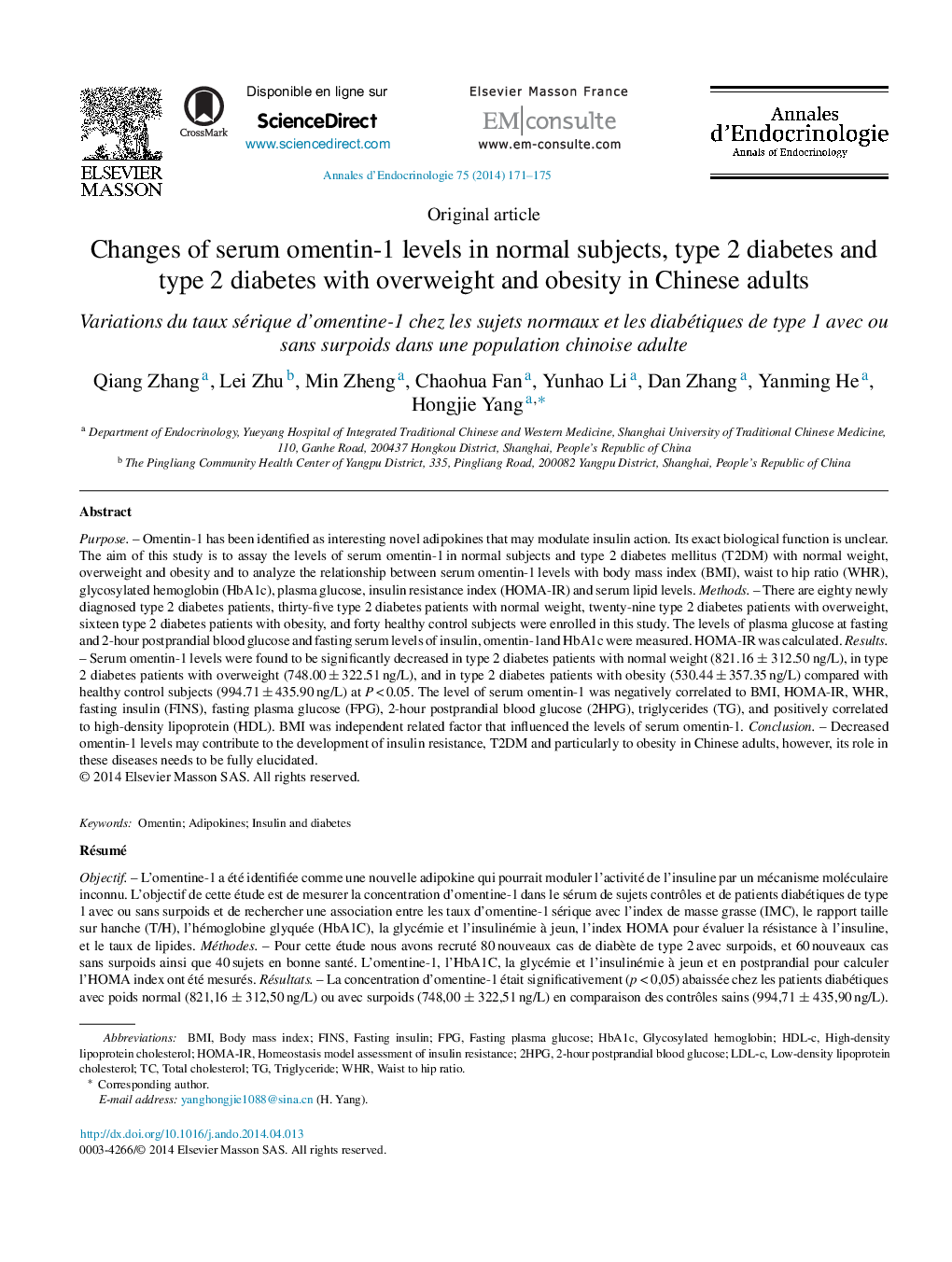| کد مقاله | کد نشریه | سال انتشار | مقاله انگلیسی | نسخه تمام متن |
|---|---|---|---|---|
| 3252171 | 1207052 | 2014 | 5 صفحه PDF | دانلود رایگان |
PurposeOmentin-1 has been identified as interesting novel adipokines that may modulate insulin action. Its exact biological function is unclear. The aim of this study is to assay the levels of serum omentin-1 in normal subjects and type 2 diabetes mellitus (T2DM) with normal weight, overweight and obesity and to analyze the relationship between serum omentin-1 levels with body mass index (BMI), waist to hip ratio (WHR), glycosylated hemoglobin (HbA1c), plasma glucose, insulin resistance index (HOMA-IR) and serum lipid levels.MethodsThere are eighty newly diagnosed type 2 diabetes patients, thirty-five type 2 diabetes patients with normal weight, twenty-nine type 2 diabetes patients with overweight, sixteen type 2 diabetes patients with obesity, and forty healthy control subjects were enrolled in this study. The levels of plasma glucose at fasting and 2-hour postprandial blood glucose and fasting serum levels of insulin, omentin-1and HbA1c were measured. HOMA-IR was calculated.ResultsSerum omentin-1 levels were found to be significantly decreased in type 2 diabetes patients with normal weight (821.16 ± 312.50 ng/L), in type 2 diabetes patients with overweight (748.00 ± 322.51 ng/L), and in type 2 diabetes patients with obesity (530.44 ± 357.35 ng/L) compared with healthy control subjects (994.71 ± 435.90 ng/L) at P < 0.05. The level of serum omentin-1 was negatively correlated to BMI, HOMA-IR, WHR, fasting insulin (FINS), fasting plasma glucose (FPG), 2-hour postprandial blood glucose (2HPG), triglycerides (TG), and positively correlated to high-density lipoprotein (HDL). BMI was independent related factor that influenced the levels of serum omentin-1.ConclusionDecreased omentin-1 levels may contribute to the development of insulin resistance, T2DM and particularly to obesity in Chinese adults, however, its role in these diseases needs to be fully elucidated.
RésuméObjectifL’omentine-1 a été identifiée comme une nouvelle adipokine qui pourrait moduler l’activité de l’insuline par un mécanisme moléculaire inconnu. L’objectif de cette étude est de mesurer la concentration d’omentine-1 dans le sérum de sujets contrôles et de patients diabétiques de type 1 avec ou sans surpoids et de rechercher une association entre les taux d’omentine-1 sérique avec l’index de masse grasse (IMC), le rapport taille sur hanche (T/H), l’hémoglobine glyquée (HbA1C), la glycémie et l’insulinémie à jeun, l’index HOMA pour évaluer la résistance à l’insuline, et le taux de lipides.MéthodesPour cette étude nous avons recruté 80 nouveaux cas de diabète de type 2 avec surpoids, et 60 nouveaux cas sans surpoids ainsi que 40 sujets en bonne santé. L’omentine-1, l’HbA1C, la glycémie et l’insulinémie à jeun et en postprandial pour calculer l’HOMA index ont été mesurés.RésultatsLa concentration d’omentine-1 était significativement (p < 0,05) abaissée chez les patients diabétiques avec poids normal (821,16 ± 312,50 ng/L) ou avec surpoids (748,00 ± 322,51 ng/L) en comparaison des contrôles sains (994,71 ± 435,90 ng/L). La concentration sérique d’omentine-1 corrélait de façon négative avec l’IMC, l’HOMA index, le rapport T/H, la glycémie et l’insulinémie à jeun, la glycémie postprandiale, les triglycérides, et corrélait de façon positive avec l’HDL-cholestérol. L’IMC était le facteur indépendant prédictif du taux d’omentine-1.ConclusionLa baisse de l’omentine-1 pourrait être un des éléments de la résistance à l’insuline au cours du diabète de type 2 et de l’obésité dans la population chinoise. Le mécanisme par lequel l’omentine-1 module la sensibilité à l’insuline doit être élucidé.
Journal: Annales d'Endocrinologie - Volume 75, Issue 3, July 2014, Pages 171–175
